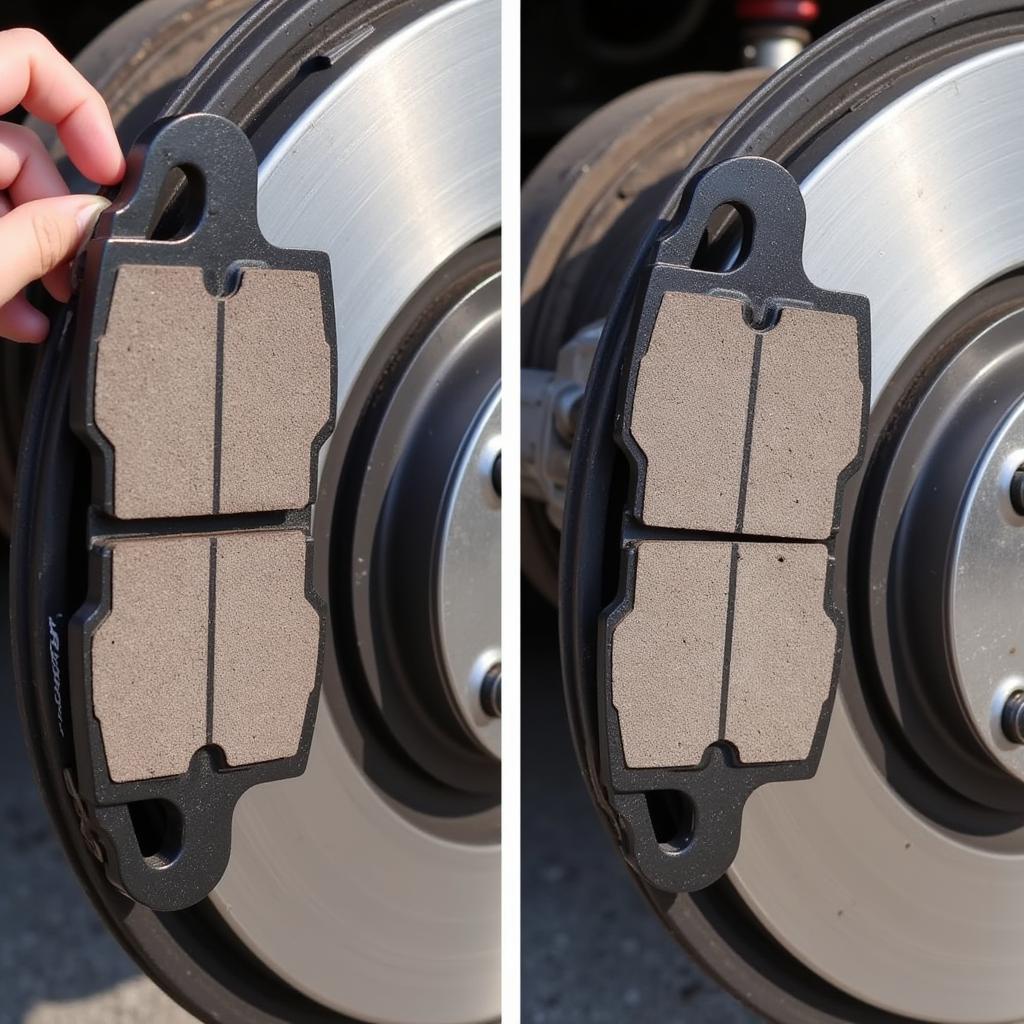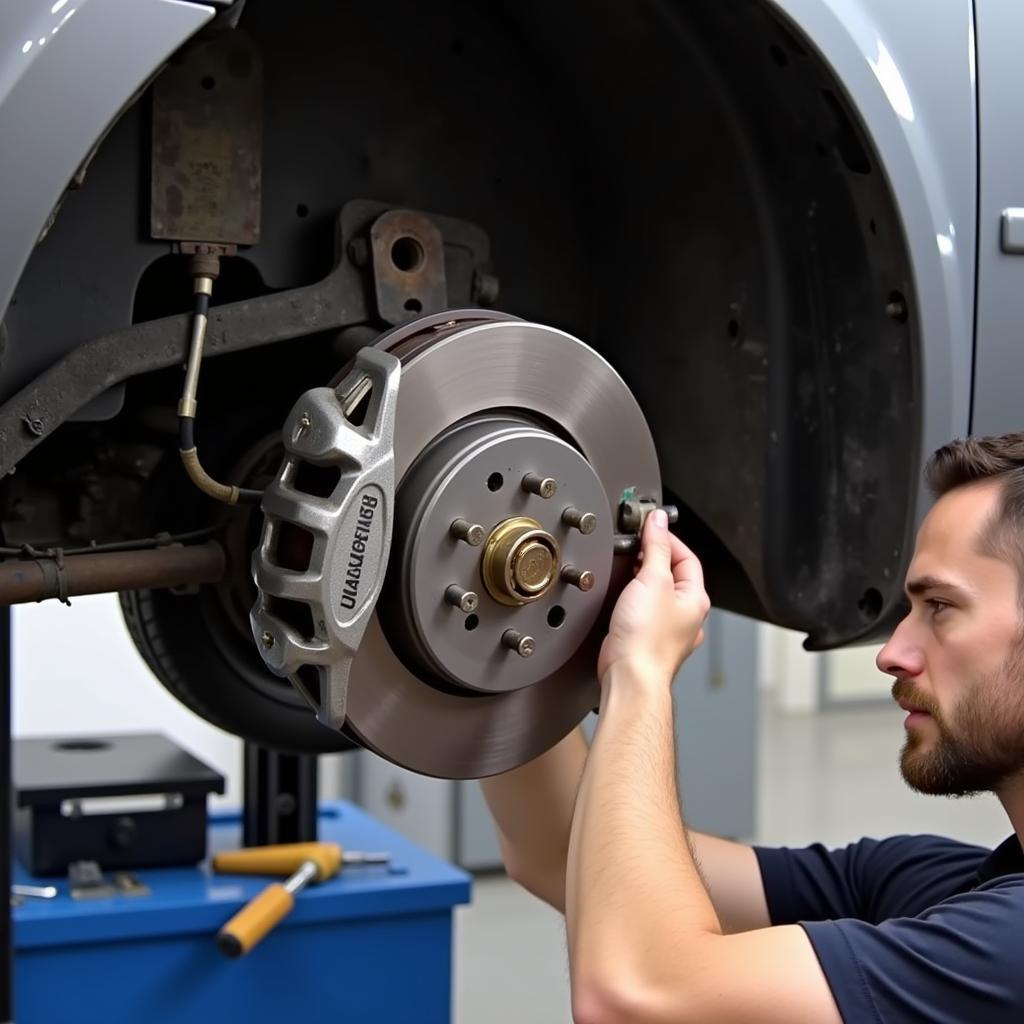A brake pad warning sensor is a small but mighty component found on many modern vehicles. It plays a crucial role in driver safety by alerting you when your brake pads are worn down and need replacing. Ignoring this warning can lead to costly repairs and compromise your ability to stop effectively. This article will delve into the intricacies of the brake pad warning sensor, covering everything from how it works to troubleshooting common issues.
How a Brake Pad Warning Sensor Works
The brake pad warning sensor is a simple yet effective system that typically consists of a sensor wire embedded within the brake pad itself.
- Sensor Activation: As you use your brakes, the brake pads wear down. Once the pad material reaches a predetermined minimum thickness, the sensor wire comes into contact with the brake rotor. This contact completes an electrical circuit.
- Dashboard Warning: Completing the circuit triggers a signal to your vehicle’s onboard computer, illuminating a warning light on your dashboard. This light is often shaped like an exclamation point within a circle or parentheses, or it might display a message like “BRAKE.”
- Audible Alert: Some vehicles also have an audible warning, such as a chime, to accompany the visual warning light, further grabbing your attention.
 Brake Pad Sensor Location
Brake Pad Sensor Location
Types of Brake Pad Warning Sensors
While the underlying principle remains the same, there are two main types of brake pad warning sensors:
- Mechanical Sensors: These are the most common type. They consist of a simple loop of wire that makes contact with the rotor when the brake pad wears down.
- Electronic Sensors: These are more sophisticated and utilize a sensor that monitors brake pad thickness. When the pad reaches a critical thickness, the sensor sends a signal to the vehicle’s computer.
Common Symptoms of a Faulty Brake Pad Warning Sensor
While the warning light is designed to alert you of worn brake pads, it can sometimes indicate a problem with the sensor itself. Here are common symptoms:
- Illuminated Brake Warning Light: This is the most obvious sign, even if your brake pads are relatively new.
- Intermittent Warning Light: The light may flicker or come on and off inconsistently.
- Continuous Screeching Noise: This could indicate a worn-out brake pad where the sensor is constantly rubbing against the rotor.
 Worn Brake Pad With Exposed Sensor
Worn Brake Pad With Exposed Sensor
Troubleshooting Brake Pad Warning Sensor Issues
Before assuming a faulty sensor, always rule out worn brake pads first.
- Visual Inspection: Check your brake pads through the spaces between your wheel spokes. If you can’t see much pad material, it’s time for a replacement.
- Professional Inspection: If your brake pads look fine, a mechanic can use a tool to measure their thickness accurately.
If your brake pads have sufficient life left, here are potential sensor-related issues:
- Damaged Sensor Wire: The wire can become broken or frayed, triggering a false warning.
- Corrosion or Debris: Buildup on the sensor contact points can interfere with the electrical connection.
- Faulty Wiring: There might be a problem with the wiring harness connecting the sensor to the vehicle’s computer.
Importance of Addressing Brake Pad Warning Sensor Issues
Ignoring a brake pad warning light, whether due to worn pads or a sensor issue, can have serious consequences:
- Reduced Braking Efficiency: Worn pads significantly reduce your vehicle’s ability to stop quickly and safely.
- Rotor Damage: Driving with worn pads can lead to metal-on-metal contact, causing deep grooves and damage to the rotors, requiring costly repairs.
- Brake System Failure: In extreme cases, ignoring the warning can lead to complete brake failure, putting you and others on the road at risk.
2012 audi a4 brake warning light
Brake Pad Warning Sensor Replacement
If your brake pad warning sensor is faulty, it’s essential to have it replaced promptly. This is a relatively simple procedure for a mechanic:
- Sensor Location: The sensor is typically located on one of the front wheels, often on the passenger side.
- Replacement Process: The mechanic will disconnect the old sensor, install the new one, and connect it to the wiring harness.
- Resetting the Warning Light: After replacement, the mechanic will use a diagnostic tool to reset the brake warning light on your dashboard.
 Mechanic Replacing Brake Pad Sensor
Mechanic Replacing Brake Pad Sensor
Conclusion
The brake pad warning sensor is a vital safety feature that helps you maintain your vehicle’s braking system. Understanding how it works and recognizing the signs of a potential problem is essential for safe and responsible driving. If you encounter any issues with your brake pad warning sensor, don’t hesitate to seek professional assistance from a qualified mechanic. Remember, prioritizing brake maintenance can save you from costly repairs and, most importantly, keep you safe on the road.
